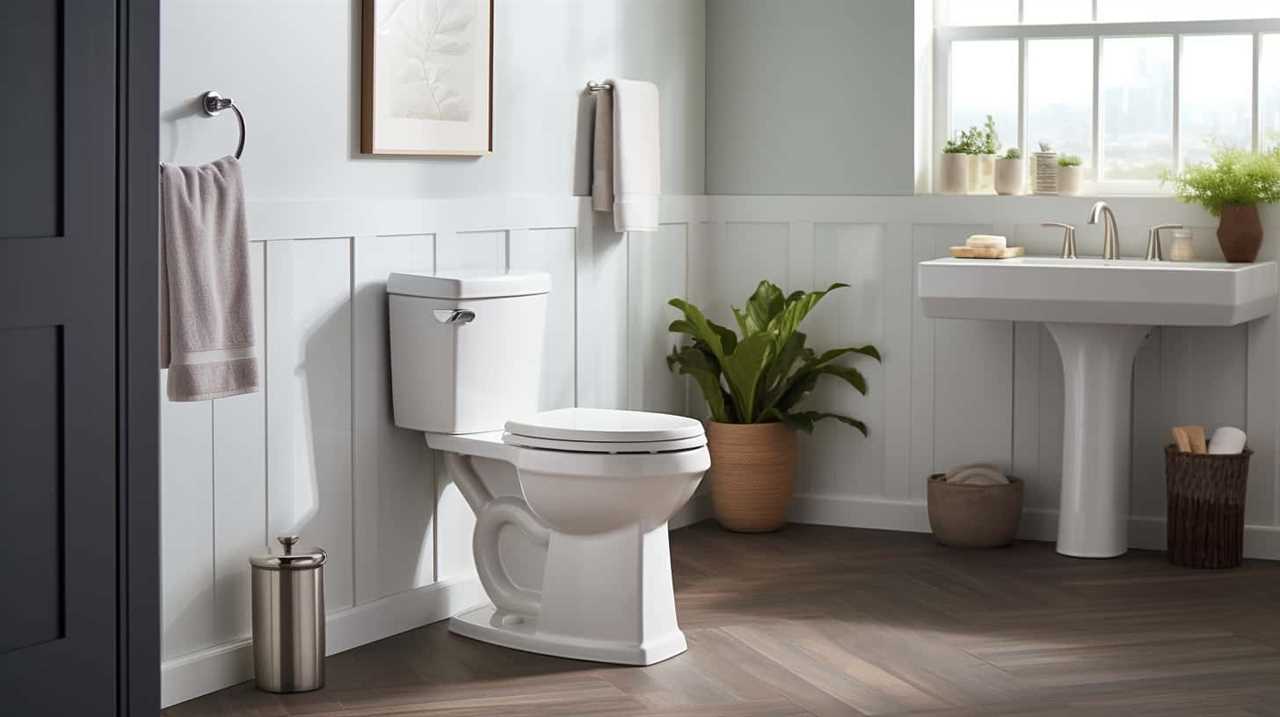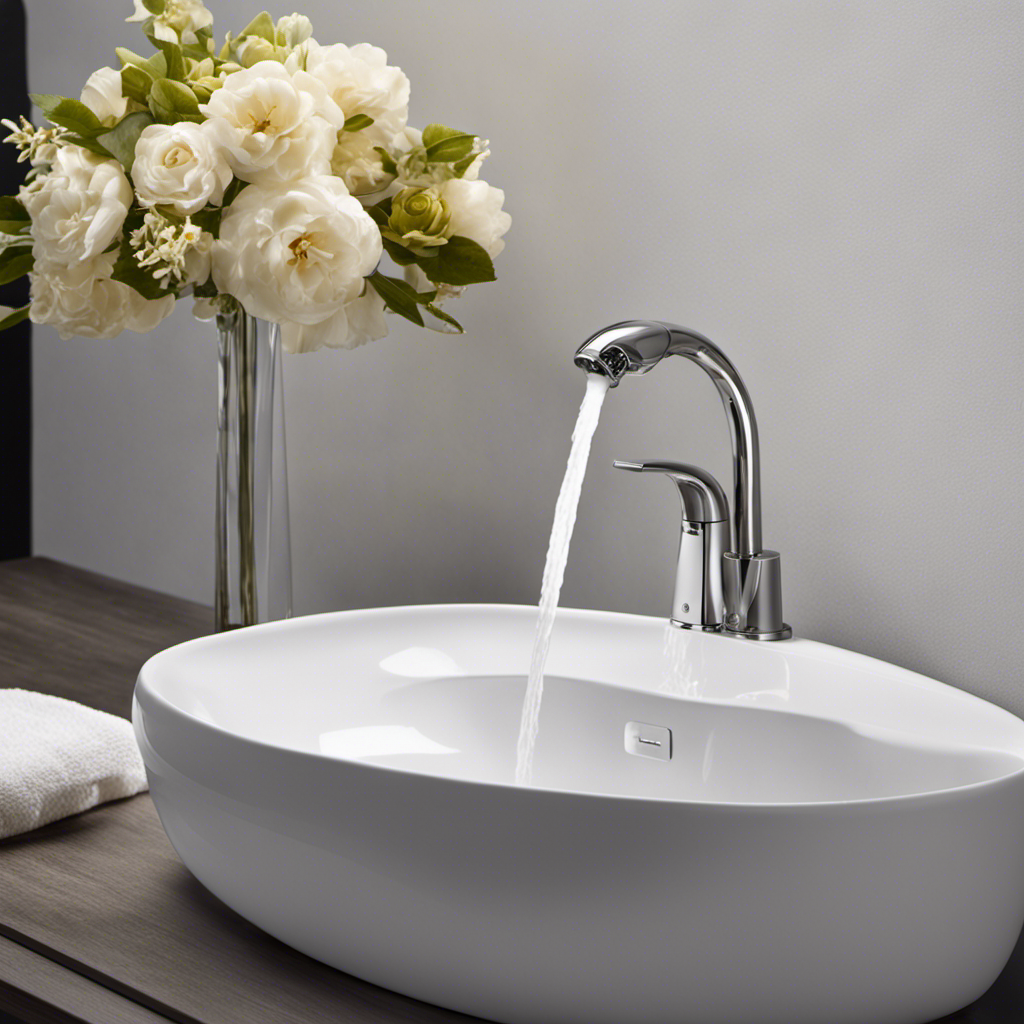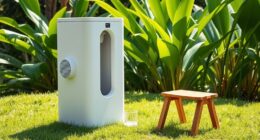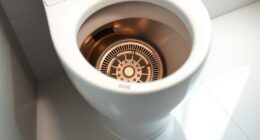To choose the right low-flow toilet, focus on water efficiency without sacrificing performance. Look for EPA WaterSense certification and models that use as little as 1.28 gallons per flush. Consider the bowl shape for comfort, and measure your bathroom’s rough-in size to ensure proper fit. Balance design, size, and features like dual-flush options to match your household needs. Keep these tips in mind, and you’ll find the perfect, eco-friendly toilet for your home.
Key Takeaways
- Check for EPA WaterSense certification to ensure water efficiency and reliable performance.
- Consider the toilet’s water usage, aiming for models with 1.28 to 1.6 gallons per flush.
- Evaluate bowl shape and seat comfort, with elongated options offering increased comfort.
- Measure your bathroom’s rough-in size to ensure the new toilet fits properly.
- Decide on features like dual-flush options to maximize water savings and meet household needs.

Upgrading to a low-flow toilet is an excellent way to conserve water and reduce your utility bills. These toilets use markedly less water per flush compared to traditional models, making them an eco-friendly choice for any home. When selecting the right low-flow toilet, you want to focus on water efficiency without sacrificing performance. Look for models labeled with the EPA WaterSense certification, as they meet strict standards for water savings and performance. This guarantees you’re getting a product designed to use less water while still providing effective flushing power.
Choose EPA WaterSense certified low-flow toilets for efficient, eco-friendly flushing without sacrificing performance.
Before you buy, measure your existing toilet’s rough-in size, which is typically 12 inches but can vary. Knowing your rough-in measurement helps prevent buying a model that won’t fit your bathroom’s plumbing. Also, consider the shape of the bowl—elongated seats tend to be more comfortable and can improve user experience. When it comes to water efficiency, some low-flow toilets use as little as 1.28 gallons per flush, but keep in mind that lower water consumption might sometimes impact flushing performance. Strike a balance between water savings and reliability to guarantee you won’t have to deal with frequent clogs or inadequate flushing.
Installation tips are vital if you’re planning to replace your old toilet yourself. First, turn off the water supply and drain the tank completely. Remove the old toilet carefully, making sure to clean the flange thoroughly. When installing your new low-flow toilet, guarantee the wax ring is seated properly to prevent leaks and odors. Tighten bolts evenly to avoid cracking the porcelain. It’s also wise to check that the toilet is level, as an uneven install can cause wobbling or leaks over time. If your bathroom plumbing has unique features or irregularities, consulting the manufacturer’s installation instructions or seeking professional help might be beneficial. Proper installation is key to maximizing water efficiency and maintaining the longevity of your new toilet.
Finally, consider the overall design and features of the low-flow toilet. Some models include dual-flush options, allowing you to choose between a full or partial flush depending on the waste. These options further improve water efficiency and reduce unnecessary water use. By choosing a model that fits your bathroom’s size, style, and your personal needs, you’ll enjoy both environmental benefits and cost savings. Remember, selecting the right low-flow toilet involves understanding your household’s water use habits and ensuring the installation is done correctly to optimize performance and durability.
Frequently Asked Questions
How Do Low-Flow Toilets Compare in Cost to Traditional Toilets?
Low-flow toilets generally cost more upfront than traditional toilets, but the cost comparison shifts over time because of lower water bills. You’ll save money on your monthly utility bills, offsetting the higher installation expenses. Keep in mind that installation might be slightly more costly if adjustments are needed, but overall, low-flow toilets are a smart investment that pays off through reduced water consumption and long-term savings.
Are Low-Flow Toilets Suitable for All Types of Plumbing Systems?
Think of your plumbing system as a garden’s delicate ecosystem—you need the right environment to thrive. Low-flow toilets generally suit most plumbing setups, but you might face installation challenges if your pipes are old or have low water pressure. Check plumbing compatibility first, and consider professional advice to avoid surprises. With proper assessment, these eco-friendly fixtures can fit seamlessly into your home without disrupting your plumbing’s harmony.
What Maintenance Is Required for Low-Flow Toilets?
You should regularly maintain your low-flow toilet by checking the flapper and replacing it if it’s worn or leaking. Sediment buildup can affect flushing, so remove sediment from the tank and bowl periodically. Also, inspect the fill valve and handle for proper operation. These simple steps help guarantee your toilet functions efficiently, conserving water and preventing costly repairs down the line.
Do Low-Flow Toilets Have Any Impact on Water Pressure?
Water pressure and flushing performance can be impacted by low-flow toilets, but it largely depends on your home’s plumbing. If your water pressure is low, you might notice weaker flushes or longer refill times. However, modern low-flow models are designed to optimize water efficiency without sacrificing performance. You should check your home’s water pressure and select a high-quality, well-rated toilet to guarantee consistent flushing power and avoid pressure problems.
How Long Do Low-Flow Toilets Typically Last?
Low-flow toilets typically last 10 to 15 years with proper maintenance. You might face installation challenges initially, but they’re worth it for their environmental benefits. Regular cleaning and timely repairs can extend their lifespan. Keep in mind, selecting a model with durable parts helps guarantee longevity. By investing in a quality low-flow toilet, you’ll enjoy efficient water use and avoid frequent replacements, saving you money and conserving resources over time.
Conclusion
Now that you know what to look for, choosing the right low-flow toilet becomes a breeze. Remember, it’s better to invest a little time now than to face regrets later. Picking the right model saves water, cuts costs, and keeps your home eco-friendly. Don’t put all your eggs in one basket—consider your needs carefully. With the right choice, you’ll be sitting pretty, confident that you’ve made a smart decision that benefits both your wallet and the planet.









